|
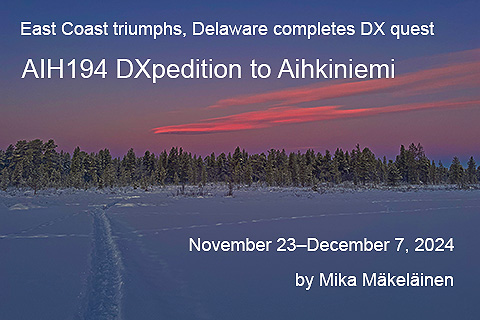
Throughout the entire two-week
expedition, AM stations from the US East Coast were
heard every day and almost around the clock. If
this is what a solar maximum offers, I'm ready for
more! Comparing reception conditions between Aihkiniemi
and Kontio, a nearby remote DX site, was enlightening.
Surprisingly, I discovered that stations faded in
and out at significantly different times, despite
the close proximity of these two locations. Fittingly,
the final station heard on this DXpedition was from
my last missing US state, Delaware.
After an exhaustive reporting stint in the United
States covering the November elections and president-elect
Trump's first cabinet choices, I found myself packing
for a decidedly different adventure. Gone were the
formal suits, ties, and earpiece, replaced by several
5 TB hard drives and attire suited for the stark
Arctic wilderness. My target? To hear remote North
American AM stations from 4,000–5,000 miles
(6,500–8,000 km) away.
For the first time, a family
member would join me on an expedition to Aihkiniemi.
My elder son, Pyry, and his boyfriend Leo were to
share the cabins, eager to hone their night sky
photography skills. With zero light pollution and
zero electrical interference, Aihkiniemi’s
DX base is a haven for both aspiring astrophotographers
and seasoned radio enthusiasts. Indeed, this
area ranks among Europe’s finest for stargazing.

The Aihkiniemi DX paradise
consists of two small and modest cabins.
This season, my SDR recordings
have been bountiful, thanks to a new remote listening
station, Kontio, established in late September with
fellow DXers. While Kontio features only one Beverage-type
antenna pointing at 302 degrees, Aihkiniemi boasts
13 such antennas to all directions, ensuring optimal
reception from any geographical area at any given
time.
Thus, a remote base does not
eliminate the need for a DXpedition to Lapland.
Here is an overview of the current antenna azimuths
in Aihkiniemi:

Equipment-wise I was using three
Perseus receivers to record the entire AM dial.
The listening room table was covered with laptops,
antenna splitters, hard drives and coax cables.
To operate the Perseus, I use exclusively the fabulous
Jaguar software, which has been tailormade for this
kind of AM DXing.
After a disappointing fall season, and particularly
after a week of proton-induced radio silence during
my previous DXpedition
AIH191 in October, this 194th DXpedition to
Aihkiniemi revived my enthusiasm for AM DXing, even
during the solar maximum. Conditions generally improved
during the first week, and I was particularly pleased
to catch so many US East Coast stations.
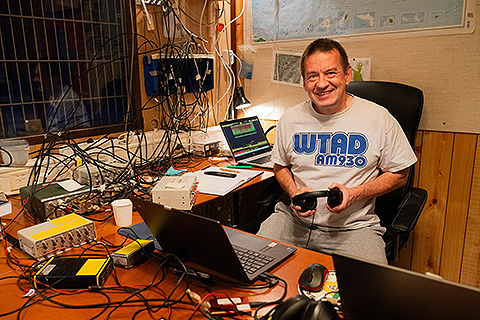
I heard WTAD from Quincy,
Illinois, already back in 2010, when WTAD made a
news
story about my reception and kindly sent me
a t-shirt. I'm still wearing it!
It was also extremely interesting
to compare reception at Aihkiniemi and Kontio, which
was only some 13 kilometers away. In cases where
multiple stations fought over a single frequency,
very often they faded in and out at different times
in these two locations.
For example, once on 980 AM, in Aihkiniemi I identified
WDYN Rossville GA, and at the same time WDDO Perry
GA was heard in Kontio! Both stations are very rare,
and I don't think that WDYN has even been heard
in Finland previously, but they are located in the
same state, and were now audible at the same time
— but in different nearby locations!
Here is a more detailed travelogue
of the AIH194 adventure, day by day:
Friday,
November 22, 2024
Pyry and Leo arrived at our place
around 4 p.m., after which we packed all our equipment
into my Auris. Winter had firmly arrived, and the
roads in the capital region were laden with snow
and slush, aptly coinciding with the conclusion
of the "Slush" start-up fest. As we drove
toward Helsinki, we witnessed a car ahead slip off
the road, landing on a snow pile before regaining
its path.
We arrived at the Pasila car-carrier
station well ahead of schedule, being the first
in line to load our car. Then, we waited. And waited
a bit more. Eventually, it became apparent that
the state railway company VR was experiencing significant
issues with its trains due to the winter storm.
Some car transporters were replaced, and we barely
managed to board the train just before its scheduled
departure. The actual departure would be very late.
We spent our waiting time at
the Tripla Mall, keeping a close watch on VR's announcements.
It was clear our train would be late, though the
extent of the delay remained uncertain. We enjoyed
a fusion Asian buffet dinner at Restaurant Teppanyaki,
occasionally darting downstairs to check our train's
status. Eventually, we had ample time to dine and
continue waiting. When the train finally departed,
about 1.5 hours late, further issues at the car-carrier
station extended the delay to over three hours.

Mika, Pyry and Leo in front
of the Aihkiniemi cabin.
Saturday, November 23,
2024
The train arrived in Rovaniemi
just under two hours late, entitling us to a 25%
refund on the ticket price — a notable sum
given the expense of overnight train travel with
a car.
It was nearly 10 a.m. when we
set out north. Road conditions were decent; it was
below freezing, but the roads became icy only after
three hours of driving near Saariselkä. Numerous
reindeer were on the road near Rovaniemi, but we
managed to avoid any accidents. We even spotted
a fox by the roadside.
We stopped for breakfast in Sodankylä
and in Ivalo we briefly met Jari Luoma and Timo
Metso, who had just completed a productive DX week
in Aihkiniemi. We then visited Alko in Ivalo for
you know what, a Neste service station in Inari
for gas and hamburgers, and finally the K-Market
of Inari for a week's worth of groceries. We arrived
in Aihkiniemi so late that that I got my first recordings
running at 1615 UTC.
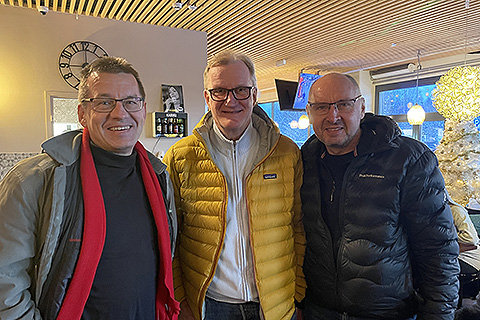
Mika, Timo Metso and Jari
Luoma in Ivalo.
Sunday, November 24, 2024
As soon as there was daylight,
we went to check the antennas. On a crisp, sunny
day, Pyry and I tackled the first two wires, giving
Pyry a taste of the tough work involved. We returned,
sweating and ready for a hot shower.
The radio dial remained lackluster.
In the afternoon, strong signals came from across
Asia, but no single direction was dominant, leaving
the dial occupied by typical powerhouses.
Leo prepared a delightful pasta,
and we continued enhancing our equipment. In the
evening, the sky was clear, allowing Pyry and Leo
to enjoy hours of stargazing and star photography
in relatively mild winter weather — hardly
any wind and just 5–10
degrees below freezing. Late in the evening, I also
captured some photos of the aurora borealis, which,
though not particularly strong, were rich in color.
We apparently missed a more impressive light show
in the early morning hours when we were already
asleep.
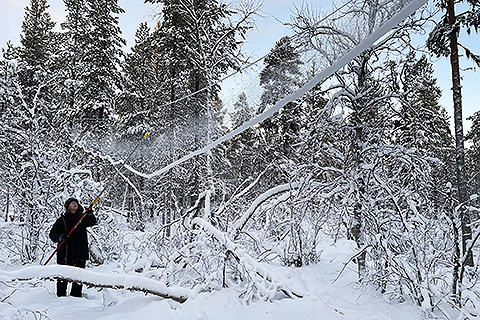
Pyry cleaning an antenna,
above, and one of his astro photos below: Polaris
(the North Star) with integrated flux nebula. The
total exposure time was 5800 seconds, over one and
a half hours. Imagine that! Click this photo (and
all the others) to open it in full size in another
browser window.

Monday, November 25, 2024
US stations emerged from the
static after midnight UTC and remained strong until
around 1000 UTC, making this my best DX day this
fall. However, most of the prime catches were made
at our nearby Kontio remote listening site rather
than Aihkiniemi. The conditions favored a narrow
slice of the East Coast, precisely the intended
target area of the Kontio wire. I was particularly
pleased to find new stations from Virginia, North
Carolina, South Carolina, Georgia, and Florida,
which are often overshadowed by more northern stations.
Overnight and morning hours added
another 15 cm of snow, complicating matters slightly.
Daylight hours were few and precious, so as soon
as it was light enough to walk in the forest around
10:30 a.m., I checked two more antennas, our Latin
America wires at 255 and 270 degrees.
Strong winds had resulted in
an even snow cover, although the ground beneath
was uneven and treacherous. Each step was a surprise,
as you never knew how deep your foot might sink
or what lay beneath. Once, I fell face-first into
the snow because my foot sank into a deep hole.
Another time, I stepped into a snow-covered stream
and got slush in my right boot. Such is the struggle
we endure for the ultimate DX.
In the afternoon, Asian stations
were quite strong from around 1200 UTC, though I
am yet to determine what I captured in my SDR recordings.
Browsing through this morning's recordings proved
more interesting.
US stations began reaching our
cabin very early on Monday evening, with the first
signals from New England arriving before 2100 UTC.
A couple of common daytime-only stations were heard,
but nothing spectacular. Nonetheless, this was the
first such early opening this season.
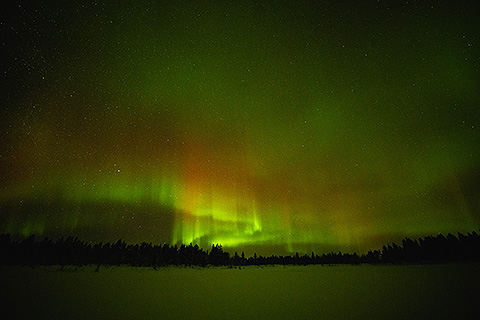
Modest aurora above Aihkiniemi.
Tuesday, November 26, 2024
The propagation pattern was strikingly
similar to Monday, with US stations remaining relatively
strong throughout the night and into the morning.
Legible graveyard stations from the Midwest were
identified as late as 1100 UTC. However, there was
less focus, and conditions were more dispersed,
making it challenging to catch anything beyond the
usual suspects.
Signals from Asia were also strong,
and I began recording Japanese stations before 1100
UTC.
In the evening, New England stations
appeared before the local sunset, but no new intriguing
catches were made.

Leo and Pyry stargazing. Using
only red light helps your eyes adjust to darkness
faster. They are using a telescope, which Jarmo
Salmi has lent for the users of Aihkiniemi.
Wednesday, November 27, 2024
Overnight and well into daylight
hours, until around 1100 UTC, US East Coast stations
were stronger than on any other night this fall.
I managed to log at least one new station from New
York, but otherwise, there was little variation,
with the usual suspects dominating the dial. Even
on graveyard channels, persistent dominating stations
like WMMB on 1240 AM, WPGG on 1450 AM, and WBAE
on 1490 AM were too strong.
Today, I made an unfortunate
error with my recordings. Japanese stations would
have been audible before the 1000 UTC NHK-1 local
station identifications, but I realized it too late,
missing the week's (or possibly the season's) best
chance to identify new NHK-1 stations.
As on previous days, I ventured
into the forest for a couple of hours, clearing
antennas of snow and checking them for any other
issues. It's quite an arduous daily routine. In
theory, there is still 1.5 hours of daylight, but
it vanishes quickly, especially with a small hill
to the south, leaving me in twilight even before
the polar night has officially begun.
In the evening, we lit a campfire
and grilled some sausages. It was -20 degrees Celsius
outside, so the fire's warmth was a welcome relief.

Pyry and Leo at the campfire.
Thursday, November 28, 2024
US stations continued their familiar
pattern, with the first signals from New England
appearing early enough for daytime catches, though
nothing extraordinary followed. During the night,
the focus shifted further west, so by daybreak,
stations from Minnesota, South Dakota, and the Midwest
dominated the dial, many remaining audible until
past 1100 UTC.
Thursday dawned crisp and clear,
with the lowest temperature so far at -25 degrees
Celsius. I checked a couple more antennas and worked
up a sweat removing a large birch that had fallen
on the 80-degree Asia antenna. Fortunately, the
antenna wire itself wasn’t broken, just pinned
to the ground by the trunk.
The wind was strong, and I ended
up covered in snow, even though it didn't snow.
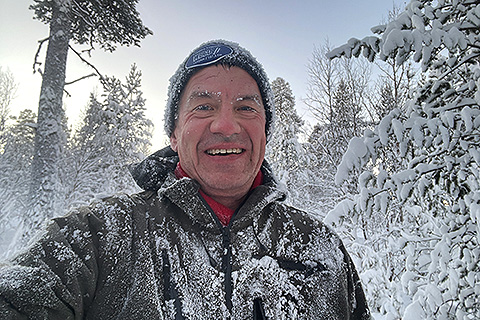
Mika after removing a large
birch from on top of an antenna.
Friday, November 29, 2024
The propagation pattern on the
AM dial seemed consistent. On the western front,
US stations appeared late Thursday evening as soon
as the sun set there, remaining audible until past
midday Friday in Finland. Identified US stations
included WMNI 920, WUZZ 1200, WCED 1420, and WKKX
1600 AM, providing a steady influx of semi-rare
East Coast stations, albeit without any truly surprising
catches.
The official length of the day
was just 26 minutes, but a few hours of meager daylight
allowed me to exercise, as on all previous days.
Today, I checked the 207 and 60-degree antennas,
both in good condition.

Pyry DXing for the first time.
Saturday, November 30, 2024
The AM dial sounded similar to
previous days, but with slightly weaker signals
that evaporated earlier. When North American stations
are heard at good levels, it becomes impossible
to listen to South American stations, as they are
buried beneath the stronger northern signals.
With no more sunrises or sunsets
this year, Aihkiniemi has fallen below the horizon
of our closest star's rays. The polar night will
last several weeks.
At daybreak, I drove to our remote-controlled
receiving site, Kontio, to check our 302-degree
antenna, finding it in perfect shape — tight,
high, and clear of snow. Later, I stopped in the
village of Partakko to buy whitefish fillets, whitefish
roe, trout, and king crab from a local fisherman.
We enjoyed an exquisite seafood dinner on the boys'
last day here.
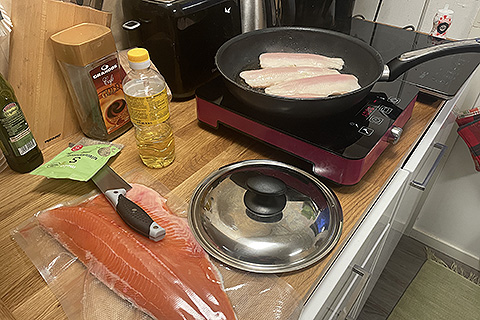
Trout and whitefish from a
local fisherman, enough for several dinners.
Sunday, December 1, 2024
The overnight opening to North
America began promisingly early, but the emphasis
shifted immediately to Minnesota and its surroundings.
Stations like 1160 KCTO MO and 1190 KKOJ MN were
identified using their daytime power before local
sunset. During the night, the opening remained steady,
with the eastern half of the US audible until around
0930 UTC, though random Western stations lingered
until at least 1400 UTC.
I spent most of the day on the
road, taking Pyry and Leo to Ivalo Airport. Our
regular spot, Restaurant Ivalo, was closed, but
we enjoyed surprisingly good hamburgers at Pubi
Restaurant across the main street. After shopping
for food, I drove back to Aihkiniemi through a heavy
snowstorm, with visibility dropping to zero whenever
an oncoming car or tourist bus passed.

A supermarket in Ivalo
welcomes you in three different Sami languages.
Monday, December 2, 2024
Overnight signals from North
America were strong, but daybreak brought about
a marked deterioration. However, the focus remained
on the US East Coast, which is always welcome.
Several technical issues complicated
the morning hours. My most important overnight recording
on the 304-degree wire had overloaded, rendering
it almost useless. Then, my primary laptop ran some
Adobe software updates, which I (mistakenly) thought
had hampered and slowed down my use of Jaguar. Finally,
a brief power outage resulted in every device rebooting,
requiring a manual restart of the Wi-Fi router.
There might have been a powerline surge at the same
time.
Snowfall was relentless, necessitating
two hours of driveway clearing in the afternoon.
In the evening, I drove to Kontio to replace a power
cable causing radio frequency interference. Whatever
Asian stations were audible remains to be seen when
I have time to review those recordings. It might
take years.

We barely saw the sun even
before the solar night set in.
Tuesday, December 3, 2024
Most of my overnight recordings
were compromised by a technical glitch. Jaguar stalled
every ten minutes, skipping minutes or even long
periods without recording. The issue spread across
all three laptop setups like a virus. The symptoms
began on Sunday and worsened gradually.
Upon inspection, I found the culprit: external hard
drives hitting 100% memory capacity while writing
data. Though each 5 TB drive still had 5–10%
free space, I decided to replace them with empty
ones. Voilà! Problem solved. I still can't
fathom why the hard drives slowed to a halt despite
having available space, but I now know what to do
if it happens again. Meanwhile, I won't be purchasing
that particular hard drive model, Western Digital
Easystore, ever again. And next winter I will only
be using SSD instead of HDD hard drives for live
recording.
Another day of similar DXing
followed, with a focus on North America. Stations
from Minnesota and South Dakota experienced a brief
resurgence before 1200 UTC, marking the first afternoon
boost of this DXpedition.
Once again, it had been snowing,
so more legwork was required outside.
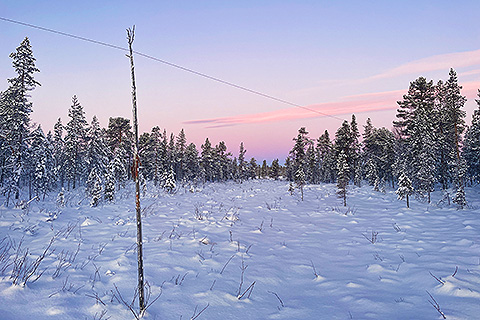
This is what midday looks
like during the polar night. The antenna wire here
is pointing at 10 degrees.
Wednesday, December 4, 2024
I botched my overnight recordings
by overloading the receivers. I had set the amplifiers
for too much amplification. Oh well, hopefully nothing
historic was missed. Conditions continued to follow
the previous days' pattern. Identified stations
included 1260 WSDZ, 1340 WNCO, 1350 BBN Panama,
1440 WEEI, 1560 KBEW, and 1570 WTWB. On the Eastern
front, Chinese stations were strong, including Wuhan
Jingji Guangbo on 1125 AM.
The day's outdoor activity was,
once again, shoveling snow. We have no shortage
of that white stuff. Later in the evening, temperatures
fell to -25 degrees Celsius, but that didn't stop
me from capturing some modest aurora borealis shots
around midnight. With no major solar storms, the
northern lights have been more subdued than expected,
despite the many clear nights offering ample viewing
opportunities.

Reindeer as seen from the
front door of Aihkiniemi.
Thursday, December 5, 2024
Radio conditions were similar
to previous days. US stations predominated, effectively
masking any potential South American signals. Stations
were heard coast to coast, with emphasis around
the Great Lakes. Minnesota stations were audible
past 1200 UTC, but no daytime-only stations were
found. This pattern is typical, making new discoveries
nearly impossible.
Logged stations included 960 WSBT, 1240 WBEJ, 1250
WJMK, 1320 KELO, 1340 KDLM, 1480 WPWC, 1490 KXRA,
1510 KMSD, 1520 KOLM, 1580 KCHA, and 1590 WALG &
KDJS & WPIW, and 1600 WKKX — none of them
new to me.
For the first time I actually
heated the sauna properly. It makes one wonder what
sort of a Finn would wait so long to use a sauna
in a cabin equipped with one. I guess the answer
is: a busy Finn.
Friday, December 6, 2024
Happy Independence Day to my
fellow compatriots! This was probably my first Independence
Day spent on a DXpedition. Not that it made much
difference on the AM dial — Finland's independence
wasn't exactly headline news elsewhere.
US stations were once again strong
and widespread, especially from around Minnesota.
The day's highlight, however, was the inaugural
broadcast of Radio Ambience on the shortwave frequency
of 6095 kHz, which was well received here in Aihkiniemi,
despite the station transmitting with only 20 watts
of power. This was already the fourth new and legal
hobbyist shortwave station to be launched in Finland
this year.

Päivi and Antti preparing
dinner.
In the evening, I took a break
from DXing and drove to Partakko to visit my friends
Antti Kokkonen and Päivi Tahkokallio at their
beautiful cabin. What a fabulous evening with sauna
and a locally hunted game meat dinner, with cured
whitefish as an appetizer. It was the best meal
of the two-week expedition.
Upon returning to Aihkiniemi,
I looked forward to meeting the next DXpeditionist.
Around midnight, I welcomed Harri Kiikeri for his
first visit to Aihkiniemi. He would spend the following
week here, but we arranged for him to arrive early
so I could show him around and he could learn the
ropes.

Mika and Harri Kiikeri on
Saturday morning, just before Mika's departure.
Saturday, December 7, 2024
Once again, fabulous AM conditions hit the dial
just as it was time to depart! Oh well, I can't
complain, since most of this DXpedition has been
well above average.
Even though I spent the morning
packing my gear and belongings, it was worth leaving
the last Perseus, coupled with a 304-degree wire,
to record the top-of-the-hour still at 1000 UTC,
midday local time, because that's when I finally
nailed my 50th US state, Delaware!
The station in question was WJWL
"La Raza" from Georgetown on 900 AM. It
is not really a huge rarity, but until now, I had
been unlucky in my hunt for many years. Not anymore.
The legal ID a bit before the hour was comprehensive
and was heard very strong. A week later my reception
report was promptly verified by President &
CEO Kevin Andrade.
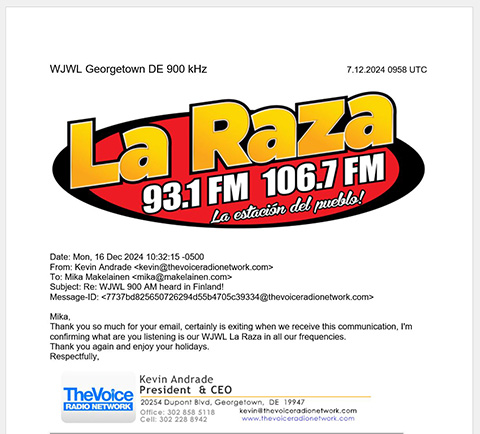
As you have read this far, you
deserve to hear some audio files as well. Here are
a few clips of US stations, which can all be considered
pretty nice catches up in Lapland:
After scoring WJWL, it was finally
time to head home. I wasn't able to enjoy driving
in daylight further than Ivalo, and driving in the
dark in Lapland is somewhat risky with all the reindeer
roaming around. Nevertheless, I made it safely to
Rovaniemi, where reindeer can mostly be found on
the restaurant menus. On Antti's recommendation,
I opted for Santa's Döner Kebab, which turned
out to be a very good and popular restaurant.
Later in the evening, I boarded the train, slept
quite well, and, for a change, the train arrived
at its destination, Helsinki, on time.
A comprehensive log will be added,
and this report will be updated as soon as I have
reviewed all recordings made during these two weeks.
That won't happen anytime soon. My guess would be
2026, at the earliest.
Text
and photos: Mika
Mäkeläinen
Published on February
2, 2025
  
|